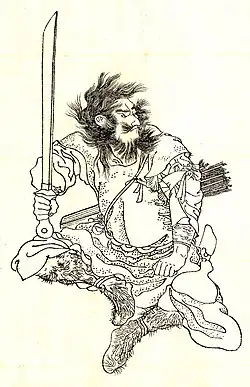Itsuse no Mikoto
| Itsuse no Mikoto | |
|---|---|
 | |
| Major cult centre | Kamayama Shrine Ani Shrine |
| Genealogy | |
| Parents |
|
| Siblings | |
Itsuse no Mikoto (Japanese: 彦五瀬命, Killed 663 BC, according to traditional dating) is a Japanese deity.[1][2] He was the older brother of Emperor Jimmu.[3][4]
His name means virtue and glory of the imperial throne.[5]
In the Kojiki and Nihongi, he died from a random arrow[6][4] during Jimmu's Eastern Expedition at a battle at the Hill of Kusaka, traditionally dated 663 BC[7][8][9][10][11] near modern day Osaka.[12] He was hit in the hand[13][14] or elbow.[15][16] He died at Mount Kama and was buried at the spot by his two remaining brothers[8][9][17][18][19] in the Kii Province.[20][17] [18][19] Some scholars believe he was Emperor before Jimmu.[8] Jimmu continued the expedition.[10][8]
He is the primary deity of Kamayama Shrine where he is buried.
Legacy
A man of the same name was sent to Tsushima Island to refine gold.[21][22][23]
Genealogy
- Red background is female.
- Green background means groups
- Bold letters are three generations of Hyuga.
References
- ^ Frydman, Joshua (2022-07-05). The Japanese Myths: A Guide to Gods, Heroes and Spirits (Myths). Thames & Hudson. ISBN 978-0-500-77735-0.
- ^ Various (2022-09-16). Japan: From the Japanese Government History. DigiCat.
- ^ Acta Asiatica: Bulletin of the Institute of Eastern Culture. Tōhō Gakkai. 1976.
- ^ a b "Kamuyamatoiwarebiko | 國學院大學デジタルミュージアム". 2023-03-21. Archived from the original on 2023-03-21. Retrieved 2023-11-23.
- ^ Authors, Various (2021-03-18). RLE: Japan Mini-Set F: Philosophy and Religion (4 vols). Routledge. ISBN 978-1-136-90356-4.
- ^ Bunko (Japan), Tōyō (1975). Memoirs of the Research Department.
- ^ Monbushō, Japan; Brinkley, Frank (1893). History of the Empire of Japan. Dai Nippon Tosho Kabushiki Kwaisha, by order of the Department of Education. Printed at the Japan Mail Office, Yokohama.
- ^ a b c d Roberts, Jeremy (2009). Japanese Mythology A to Z. Infobase Publishing. ISBN 978-1-4381-2802-3.
- ^ a b Anonymous (2023-09-29). The Great Events: Vol. 1. BoD – Books on Demand. ISBN 978-3-368-19823-7.
- ^ a b Weiss, David (2022-01-13). The God Susanoo and Korea in Japan's Cultural Memory: Ancient Myths and Modern Empire. Bloomsbury Publishing. ISBN 978-1-350-27119-7.
- ^ James, David H. (2010-11-01). The Rise and Fall of the Japanese Empire. Routledge. ISBN 978-1-136-92547-4.
- ^ Perez, Louis G. (2013-01-08). Japan at War: An Encyclopedia. Bloomsbury Publishing USA. ISBN 978-1-59884-742-0.
- ^ Olson, Carl (2005). Original Buddhist Sources: A Reader. Rutgers University Press. ISBN 978-0-8135-3564-7.
- ^ Nichiren (2003). The Writings of Nichiren Daishonin. Soka Gakkai. ISBN 978-4-88417-007-3.
- ^ Wei, Tʻing-sheng (1975). The Birth of Japan. China Academy.
- ^ Brinkley, Frank; Kikuchi, Dairoku (1914). A History of the Japanese People: From the Earliest Times to the End of the Meiji Era. Encyclopædia Britannica Company.
- ^ a b Authors, Various (2021-03-04). RLE: Japan Mini-Set C: Language and Literature (8 vols). Routledge. ISBN 978-1-136-90101-0.
- ^ a b Nihongi: Chronicles of Japan from the Earliest of Times to A.D. 697. Tuttle Publishing. 2011-07-12. ISBN 978-1-4629-0037-4.
- ^ a b Nihongi: Chronicles of Japan from the Earliest Times to A.D. 697. Society. 1896. ISBN 978-0-524-05347-8.
{{cite book}}: ISBN / Date incompatibility (help) - ^ Ashkenazi, Michael (2003-11-05). Handbook of Japanese Mythology. Bloomsbury Publishing USA. ISBN 978-1-57607-468-8.
- ^ Japan, Asiatic Society of (1934). Transactions of the Asiatic Society of Japan. The Society.
- ^ London, Japan Society of (1971). Transactions and Proceedings of the Japan Society, London. Kegan Paul, Trench, Trübner and Company.
- ^ Japan, Asiatic Society of (1934). Transactions.
- ^ a b c Borgen, Robert; Ury, Marian (April 1990). "Readable Japanese Mythology: Selections from Nihon shoki and Kojiki" (PDF). The Journal of the Association of Teachers of Japanese. 24 (1). American Association of Teachers of Japanese: 61–97. doi:10.2307/489230. JSTOR 489230. Retrieved 12 April 2020.
- ^ a b https://archive.today/20230406174104/https://d-museum.kokugakuin.ac.jp/eos/detail/?id=9716
- ^ a b c d e Nihongi: Chronicles of Japan from the Earliest Times to A.D. 697, translated from the original Chinese and Japanese by William George Aston. Book II, page 73. Tuttle Publishing. Tra edition (July 2005). First edition published 1972. ISBN 978-0-8048-3674-6
- ^ a b c Akima, Toshio (1993). "The Origins of the Grand Shrine of Ise and the Cult of the Sun Goddess Amaterasu Ōmikami". Japan Review. 4 (4): 143. ISSN 0915-0986. JSTOR 25790929.
- ^ a b c Tsugita, Masaki (2001) [1977]. 古事記 (上) 全訳注 [Complete Translated and Annotated Kojiki, Part 1]. Vol. 38. 講談社学術文庫. p. 205. ISBN 4-06-158207-0.
- ^ a b c d e The History of Nations: Japan. Dept. of education. Japan. H. W. Snow. 1910.
- ^ The Kojiki: Records of Ancient Matters. Tuttle Publishing. 19 June 2012. p. 218. ISBN 978-1-4629-0511-9.